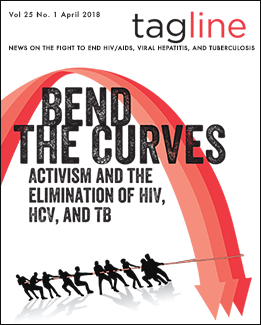By Tim Horn
Do your little bit of good where you are; it’s those little bits of good put together that overwhelm the world.
— Desmond Mpilo Tutu
 Incremental change—activism that successfully defends or advances critical research or policy—can sometimes feel inconsequential, particularly when it is hard won, resource intensive, and intangible. But in the context of public health strategies with ambitious targets and formidable stakeholder engagement, it is an undeniable facet of progress. In this issue of TAGline, we highlight some important recent successes and challenges in meeting TAG’s overarching goals: moving beyond achingly slow trends and sharply bending the curves on new HIV, hepatitis C, and tuberculosis infections, suffering, and deaths.
Incremental change—activism that successfully defends or advances critical research or policy—can sometimes feel inconsequential, particularly when it is hard won, resource intensive, and intangible. But in the context of public health strategies with ambitious targets and formidable stakeholder engagement, it is an undeniable facet of progress. In this issue of TAGline, we highlight some important recent successes and challenges in meeting TAG’s overarching goals: moving beyond achingly slow trends and sharply bending the curves on new HIV, hepatitis C, and tuberculosis infections, suffering, and deaths.
We begin with Jeremiah Johnson’s “The Usual Suspects,’ which focuses on the experiences and observations of TAG’s partners working to develop and implement plans to end HIV and AIDS as epidemics in some of the most affected states, counties, and cities.
In “The Role of Vaccines and Cures in HIV Elimination,” Richard Jefferys illustrates that, although the benefits of antiretroviral treatment and biomedical prevention are undeniable, they do not preclude the need for sustained long-term investments in the development of HIV vaccines and cures.
Shifting to the accomplishments and tasks ahead for HCV advocacy, Annette Gaudino reflects on the paradox of New York State. In “It’s Up to You, New York,” Gaudino recalls the milestones of a campaign to eliminate HCV in the state, which closely mirrors the HIV stakeholder End the Epidemic initiative, but with much more political inertia.
The World Health Organization (WHO) has established targets to eliminate HCV globally by 2030. As is evidenced in Bryn Gay’s and Gaudino’s “Global HCV Elimination Targets and Challenges: an Interview with Andrew Hill,” some countries are on track, others are lagging behind, and all are in jeopardy if they do not scale up screening, testing, and linkage to care for the more than 56 million people living with undiagnosed HCV.
In advance of the United Nations High-Level Meeting (HLM) on TB, Safiqa Khimani and Mark Harrington illustrate in “From Moscow to New York and Beyond” that the success of the HLM will require that the resulting UN General Assembly Political Declaration include clear commitments to expand the quality and breadth of TB programs and increase investment in the research and development necessary to eliminate TB as a global threat.
And in the U.N.’s host city, New York, the incidence of TB is on the rise, whereas funding to fight the disease has decreased considerably. As Erica Lessem deftly explains in “The United Nations’ Back Yard: TB Elimination in New York and the U.S.,” looking to countries to commit to global TB programs and research at the HLM is crucial, but so too is a robust local response to a growing national problem.
Finally, “In a State of Disunion,” Suraj Madoori provides a sweeping look at the precarious HIV, TB, and HCV elimination policies and priorities under the Trump administration. And although the 2018 landscape looks bleak, observations from the successful ACA, Medicaid, and NIH defenses of 2017 speak to the value of incremental change: activism can win in any policy environment seemingly stacked against it.
